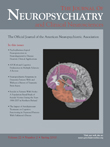A Case of Prolonged Interictal ECT-Induced Delirium
To the Editor: We present the case of a 74-year-old Caucasian man who developed severe and prolonged interictal ECT-induced delirium after being treated with ECT for worsening depression. His CT scan findings revealed evidence of chronic bilateral basal ganglia infarcts. Our case supports evidence that basal ganglia lesions have been implicated as one of the risk factors for ECT-induced delirium.
We emphasize careful consideration for ECT with close monitoring of interictal delirium symptoms in these patients. More research is warranted to understand the pathophysiology and treatment of severe and prolonged ECT-induced delirium due to limited current evidence.
Case Report
A 74-year-old man was admitted to a medical psychiatry unit for evaluation of a 1-month history of worsening symptoms of anxiety, depression without suicidal ideation or psychosis, and cognitive changes—short-term memory loss and inability to manage finances—thought primarily to be due to his worsening depression. Mini-Mental State Examination score was 24/30 without clinical evidence of delirium prior to or at the time of admission. This was his first psychiatric hospitalization after a decade of outpatient treatment for anxiety and depression, with multiple failed trials of antidepressants. Head CT scan revealed small vessel ischemic cerebrovascular disease and silent bilateral chronic basal ganglia lacunar infarcts. He had previously experienced delirium related to morphine use after knee surgery in 2006.
Right unilateral brief pulse ECT was initiated using Thymatron IV system thrice weekly with 100% stimulation doses. All psychotropic medications were tapered to discontinuation except olanzapine, 2.5 mg at bedtime. After his third treatment, he abruptly developed symptoms of disorientation, agitation, wandering, inattention, and visual hallucinations. ECT was immediately discontinued.
Thorough medical workup for underlying causes of delirium was negative except for “few gram positive bacilli” on urinalysis, thought most likely a contaminant as repeat urine cultures were unremarkable. EEG revealed generalized slowing with no epileptiform activity. A head MRI revealed no acute cerebrovascular changes.
Trials of increased olanzapine and risperidone were unsuccessful. Quetiapine resulted in partial resolution of delirium symptoms over 3 weeks with less frequent episodes of confusion, but persistence of periodic visual hallucinations. Venlafaxine was reintroduced with noticeable mood improvement. He was discharged to home with outpatient follow-up for resolving delirium and depression, though the episodes of confusion continued for several months after ECT was abandoned.
Discussion
Interictal ECT-induced delirium develops during a course of ECT and persists on days that ECT is not delivered. Risk factors include advancing age, Parkinson’s disease, Alzheimer’s disease, one or more cardiovascular risk factors, and preexisting structural changes in the caudate nucleus on brain scans. 1
Basal ganglia and subcortical white matter lesions—as our patient exhibited—may predispose to the development of interictal delirium during a course of ECT. 2 Basal ganglia and subcortical white matter have extensive connections with cortical areas known to be important to attentional processes. 3 Perhaps in some patients, lesions of basal ganglia and subcortical white matter disrupt or disconnect these pathways, resulting in an increased vulnerability to disturbances of attention and vigilance, the hallmarks of delirium. 2
Typically, delirium is short-lived, and ECT treatment should be held until the delirium resolves. Use of ultrabrief pulse width ECT may be helpful, 4 and donepezil may mitigate symptoms of severe and prolonged post-ECT delirium. 5
Current literature is essentially silent as to management of prolonged ECT-induced delirium. Further research is needed to rectify our limited understanding of pathophysiology and management of prolonged ECT-induced delirium to prevent and treat this complication in patients at risk.
1. Schatzberg AF, Nemeroff CB: Essentials of Clinical Pharmacology. Washington, DC, American Psychiatric Press, 2006Google Scholar
2. Figiel GS, Coffey CE, Djang WT, et al: Brain magnetic resonance imaging findings in ECT-induced delirium. J Neuropsychiatry Clin Neurosci 1990; 2:53–58Google Scholar
3. Jayaraman A: The basal ganglia and cognition, in Basal Ganglia and Behavior. Edited by Schneider J. Bern, Switzerland, Hans Huber AG, 1987, pp 149–168Google Scholar
4. Daniel WF, Weiner RD, Crovitz HF, et al: ECT-induced delirium and further ECT: a case report. Am J Psychiatry 1983; 140:922–924Google Scholar
5. Logan CJ, Stewart JT: Treatment of post-electroconvulsive therapy delirium and agitation with donepezil. J ECT 2000; 23:28–29Google Scholar



